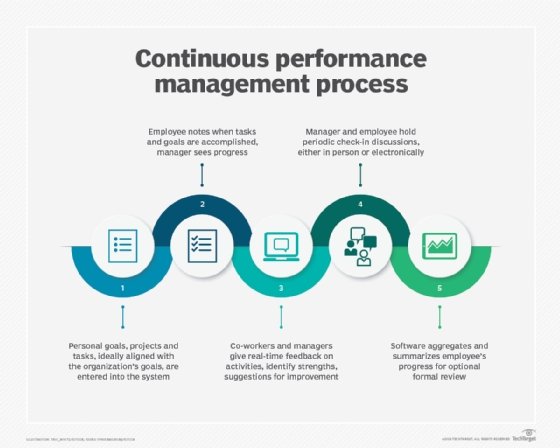
Rymden - stock.adobe.com
Top 9 performance review questions and answers
During performance review sessions, managers need to prepare the right questions for conversations with employees on the past year, career paths and goals for the upcoming year.
Annual performance reviews are a time to reflect on accomplishments and set goals for the upcoming year.
Having the right employee performance review questions can make a difference in whether the entire process is effective or not. These questions should have clear answers and relate to specific job functions. Have employees do a self-evaluation first with the same questions to take their input into consideration.
Here are some sample questions and answers to consider when conducting performance reviews.
1. What is your greatest work accomplishment over the past year?
Start the review off with a positive tone. Give the employee a chance to express their value and explain where they believe they excel.
Answers should be positive and give examples of true work accomplishments. Look for employee answers with details of leadership and working collaboratively with their team. Regular duties they should be expected to complete are not great examples. Make sure the employee explains why they are proud of this achievement and how they see it added value.
Be wary if the employee tries to take credit for another person's accomplishment. The employee should be honest with this answer but not try to take credit for something they are not responsible for.
2. What are your goals for next year?
Settings goals lets managers see how they can help employees with training or coaching during the year. Look for detailed goals that show the employee is strategically thinking about their future. Their goals should be realistic and attainable.
Follow the SMART goal format, which means the goals are the following:
- Specific
- Measurable
- Achievable
- Relevant
- Timebound
Learn about SMART goals for a QA analyst.
3. What areas would you like to improve?
This question doesn't have any bad or good answers -- it gives managers an idea of the employee's perception of their weaknesses. Managers can also find ways to help employees improve. The answers an employee gives can provide insight about how to manage a person and give them ideas to make them a better employee.
However, if an employee refuses to acknowledge any weaknesses, the person may be arrogant or not see they need to make improvements. There is always room to grow, and this is not about showing what a person does badly, but looking at areas of improvement. Examples of what employees may say here are leadership, knowledge of a certain business area, time management or presentation skills. All of these are improvements where managers can help set goals.
By asking the employee to answer for themselves, it gives the employee the chance to reflect on their skills and not see this as criticism from their superior. It also gives you an idea of the employee's thoughts and how they match up to your perceptions of their work and skill level.
Creating a continuous learning culture with areas of improvement helps employees grow and not feel complacent in their roles.

4. How can management help you reach your goals?
This question lets managers see where they can help and if there is something that isn't working well. You can see how your management style affects employee relations and workload.
Trust is the key factor here, and some of these answers may help managers set goals to improve employee performance. Performance reviews also help managers get constructive feedback on their skills by opening a two-way conversation.
5. Which job responsibilities do you enjoy most?
Managers who ask employees why they like these tasks may find other similar areas to help them further their careers. Typically, employees choose responsibilities that cater to their strengths, so find ways to include these responsibilities -- or similar ones -- in their job duties.
6. Do you have everything you need to do your job?
This can help managers find out how to improve an employee's productivity if there is something they don't currently have and need. Ask them how new tools and resources would have a positive effect, and look for concrete examples to prove they are necessary. Examples of these tools and resources include training materials, classes, seminars and office equipment.
If an employee asks for tools and resources that are unattainable, figure out why they need them, and be sure they understand the parameters and restrictions of their work. These requests must align fully with their current job for consideration.
7. Do you feel your team works well together?
Most employees work on a team, and the dynamics of this group have an effect on productivity. Managers need to ensure an employee works well with other team members. Managers can learn about the team's interactions and see if there is anything they're able to do to address any problems.
Try to get honest answers, and check to make sure the team relationship appears healthy and there is no covering up for a teammate or animosity. Ask the employee to be honest with you if there is another employee hindering their performance to see how you can fix or encourage better interactions.
8. Where would you like to see yourself in the company in the short term and long term?
Asking about career aspirations beyond establishing goals for next year lets managers gauge how you can help employees reach these goals. Managers can find career paths that match an employee's interests and ambitions and set achievable goals to get them there.
Ongoing development plans should outline the skills gaps and help employees learn the necessary skills. Managers can also provide input on an employee's strengths and whether they think another position within the company may be a good fit down the road.
When reviewing answers, managers need to be sure employees have a clear understanding of the company's hierarchy and have reasonable expectations. Employees should demonstrate their drive and not feel entitled to an executive position without working hard.
Learn about these top learning experience platforms for employee development.
9. Do you have any additional comments or questions?
This question gives employees a chance to add additional comments, concerns and questions. There isn't a right or wrong answer here, and employees may not have any additional comments.
This is also an opportunity to build trust with employees and reiterate positive thoughts on their performance. Managers can also address company culture and see if the employee has any thoughts for improving.
Other considerations for the employee review
Managers should schedule a performance evaluation meeting to give plenty of time for both parties to prepare and reflect on the previous year. Ample time gives the employee time to collect examples and think about projects.
Keep the review conversational. The review should not be one-sided as both managers and employees have valuable input and should share it with one another.
The performance review should highlight both positive and missed opportunities. Managers shouldn't focus too much on one side and instead present ways to address improvements to avoid dwelling on negatives.
Always end with the next steps and desired outcomes to set clear expectations. Managers should follow up with employees regularly to see how the goals are going and if they can help in any way. Weekly check-ins are a great way to stay on track and be ready for the following year's employee review. Regular contact also helps keep employees engaged.








